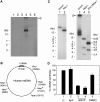Differential regulation of full-length genome and a single-stranded 7S DNA along the cell cycle in human mitochondria
- PMID: 20530535
- PMCID: PMC2965228
- DOI: 10.1093/nar/gkq493
Differential regulation of full-length genome and a single-stranded 7S DNA along the cell cycle in human mitochondria
Abstract
Mammalian mitochondria contain full-length genome and a single-stranded 7S DNA. Although the copy number of mitochondrial DNA (mtDNA) varies depending on the cell type and also in response to diverse environmental stresses, our understanding of how mtDNA and 7S DNA are maintained and regulated is limited, partly due to lack of reliable in vitro assay systems that reflect the in vivo functionality of mitochondria. Here we report an in vitro assay system to measure synthesis of both mtDNA and 7S DNA under a controllable in vitro condition. With this assay system, we demonstrate that the replication capacity of mitochondria correlates with endogenous copy numbers of mtDNA and 7S DNA. Our study also shows that higher nucleotide concentrations increasingly promote 7S DNA synthesis but not mtDNA synthesis. Consistently, the mitochondrial capacity to synthesize 7S DNA but not mtDNA noticeably varied along the cell cycle, reaching its highest level in S phase. These findings suggest that syntheses of mtDNA and 7S DNA proceed independently and that the mitochondrial capacity to synthesize 7S DNA dynamically changes not only with cell-cycle progression but also in response to varying nucleotide concentrations.
Figures





References
-
- Anderson S, Bankier AT, Barrell BG, de Bruijn MH, Coulson AR, Drouin J, Eperon IC, Nierlich DP, Roe BA, Sanger F, et al. Sequence and organization of the human mitochondrial genome. Nature. 1981;290:457–465. - PubMed
-
- Schapira AH. Mitochondrial disease. Lancet. 2006;368:70–82. - PubMed
-
- Schon EA. Mitochondrial genetics and disease. Trends Biochem. Sci. 2000;25:555–560. - PubMed
MeSH terms
Substances
LinkOut - more resources
Full Text Sources
Other Literature Sources

